Around 75% of businesses believe using various digital marketing strategies helps enhance their brand’s credibility and customer trust. This means most brands prefer digital marketing over traditional marketing to promote their businesses and reach their target audience.
With the drastic adoption of this approach, the internet marketing industry is expected to reach $807 billion by 2026. If you’re a business owner or planning to shift to digital advertising, it’s essential to have a detailed plan in place. It’ll help you smoothly navigate all the necessary marketing campaign steps.
Here’s everything you need to know about crafting a top-notch digital marketing strategy for your business to attract a loyal customer base and deliver maximum ROI.
What is a digital marketing strategy?
A digital marketing strategy is a set of planned tactics that involves leveraging internet tools and resources to promote a business online to a broader audience and further improve its brand awareness digitally.
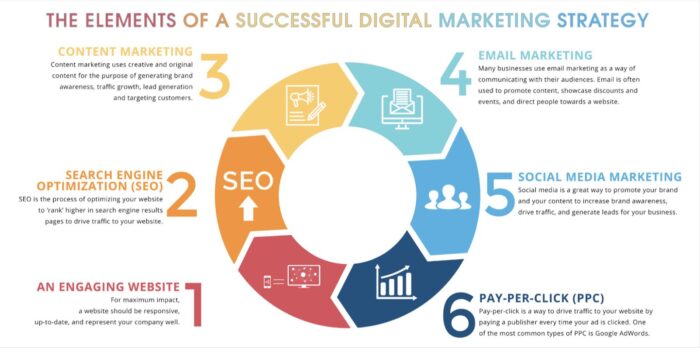
Image credit: On Top Visibility
Successful marketers know a comprehensive digital marketing strategy is crucial for improving brand awareness and driving growth. This type of digital marketing involves leveraging various online channels and tools, such as social media advertising and paid media, to create action plans that guide marketing activity and improve customers’ experiences.
To help your brand stand out from the competition and reach your target audience effectively, consider utilising these top digital marketing channels:
- Search Engine Optimisation (SEO).
- PPC marketing (Pay-Per-Click, like Google Ads).
- Content marketing.
- Social media marketing.
- Email marketing.
- Influencer marketing.
- Video advertising.
7 steps to building an effective digital marketing strategy
In today’s digital age, having a robust digital marketing strategy is essential for businesses to thrive and remain competitive. Here are the steps to build an effective plan and reach your target audience online.
Step 1: Conduct research
In-depth research on your business is always a good option before constructing a digital marketing strategy. This will help to provide insights into your target audience, competitors, and market conditions.
Audience
Create a buyer persona of your target audience and gather customer data using various channels, platforms, and software. By understanding the prospective customer’s purchasing power, demographics, buying patterns, and behaviour, you can create advertising campaigns to target the correct audience.
Have you ever heard the expression advertising waste? This situation often occurs for many businesses when a brand’s advertising campaign fails to deliver the desired results due to targeting the wrong audience or other factors.
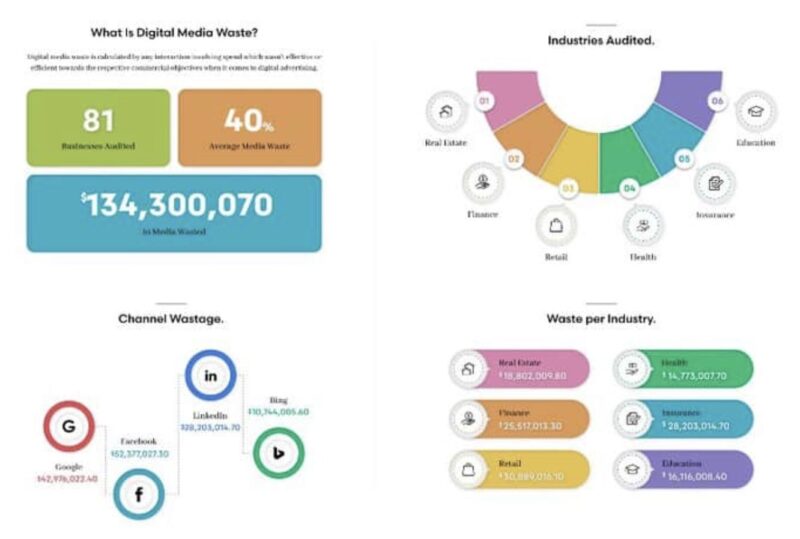
Image credit: Mediaweek
Advertising inefficiency is a significant challenge many businesses face, often due to broad ad targeting. This wastes precious resources by targeting the wrong audience and ad groups.
The above image from Mediaweek shows that in the second half of 2021, brands wasted approximately $134,000,000 due to this inefficiency. This figure is staggering and highlights the pressing need for brands to target the right audience to achieve their advertising goals.
Competitors
Conducting competitor research is crucial to creating a digital marketing strategy. This involves gathering information about your competitors’ digital marketing tactics, including their target audience, ad campaigns, and content strategies.
To do this, consider auditing your competitor’s digital marketing strategies by looking under the hood at their strategies and tools.
For instance, imagine you’re running an Ecommerce business competing with a major player like Catch. If you want to audit their marketing channels to gain a competitive edge, here are some steps you can take:
Social media audit
You can use tools like Sprout Social or Hootsuite to evaluate your competitors’ social media profiles and content performance. However, it’s important to note that many brands and influencers may have fake followers or engagement, which can skew their performance metrics.
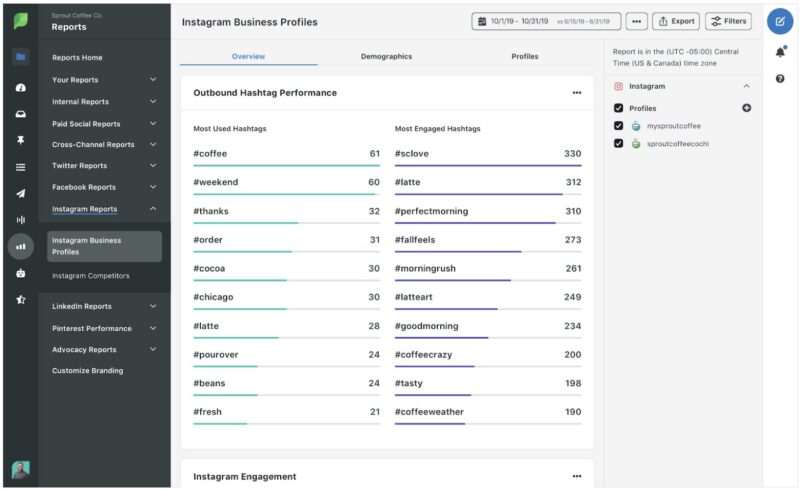
Image credit: Sprout Social
To determine whether a brand or influencer has genuine engagement, you can use tools like HypeAuditor, Social Blade, or IG Audit, which analyse various metrics to provide insights into the authenticity and engagement level of social media accounts.
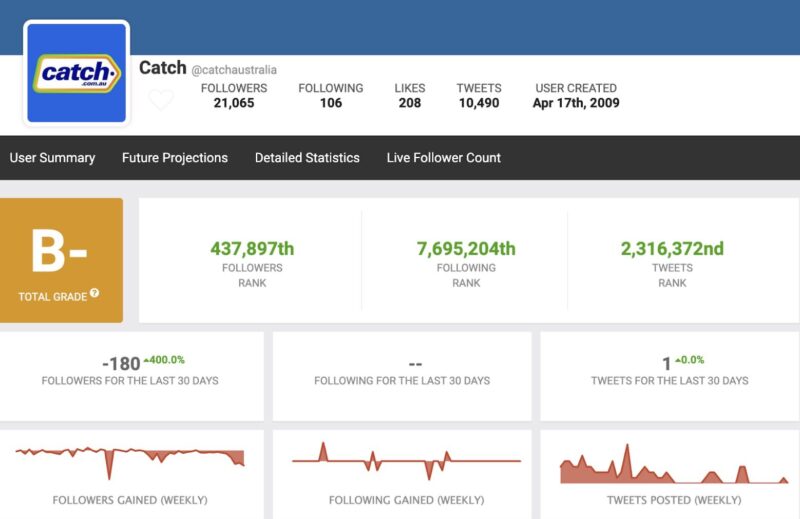
Image credit: Social Blade
It’s also important to consider the specific social media channels relevant to your industry. For example, if you’re in the fashion industry, you may want to focus on Instagram and TikTok, while if you’re in B2B, LinkedIn may be a more relevant platform to analyse.
To illustrate with an example, let’s look closely at Catch and examine a few of its social media strategies.
X
Catch has 21,000 followers. If you scroll through their feed, you’ll immediately notice that many of their posts are not getting any user engagement. This means that their content may not be resonating with their audience, or they may not have an engaged following.
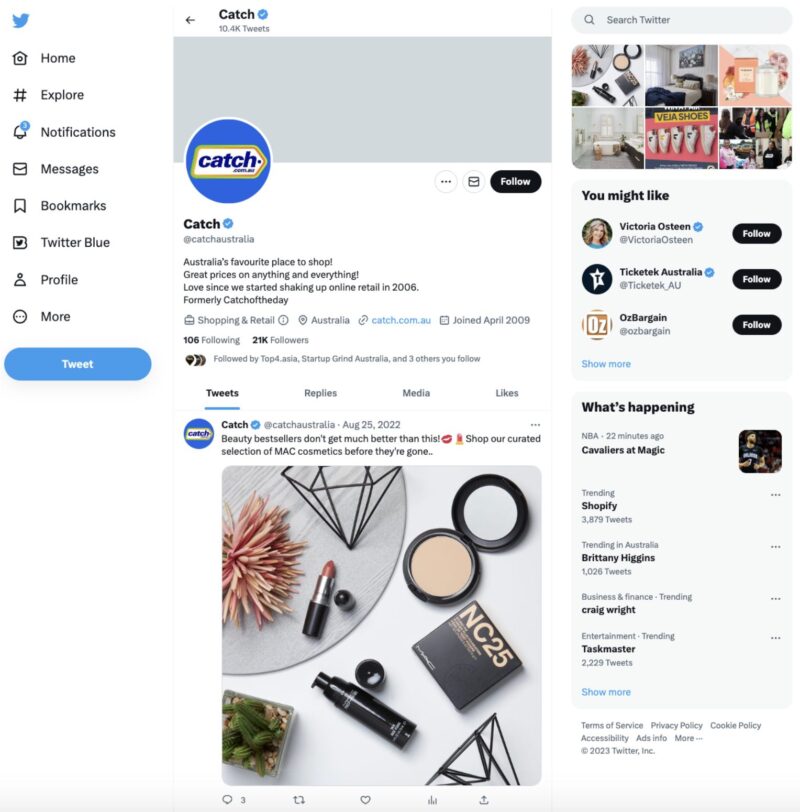
Image credit: X
It could also indicate fake followers or that X may not be the most effective digital marketing channel for Catch as their target audience may not be active on X as on other platforms like Facebook, TikTok or Instagram.
One reason could be that X has a more extensive user base in the United States than Australia. According to recent data, as of January 2025, there were approximately 105 million X users in the United States, while Australia had around 5.2 million.
While X may be more popular and widely used in the United States than in Australia, businesses should evaluate its suitability for their target audience and marketing goals in each market.
Catch has 67,200 followers. If you take a look at their engagement, it’s mixed. Some posts might have around 20 hearts (hearts serve as a like), while others may have between 100 and 600 plus likes.
For instance, this image in the centre featuring two children has garnered over 600 likes.
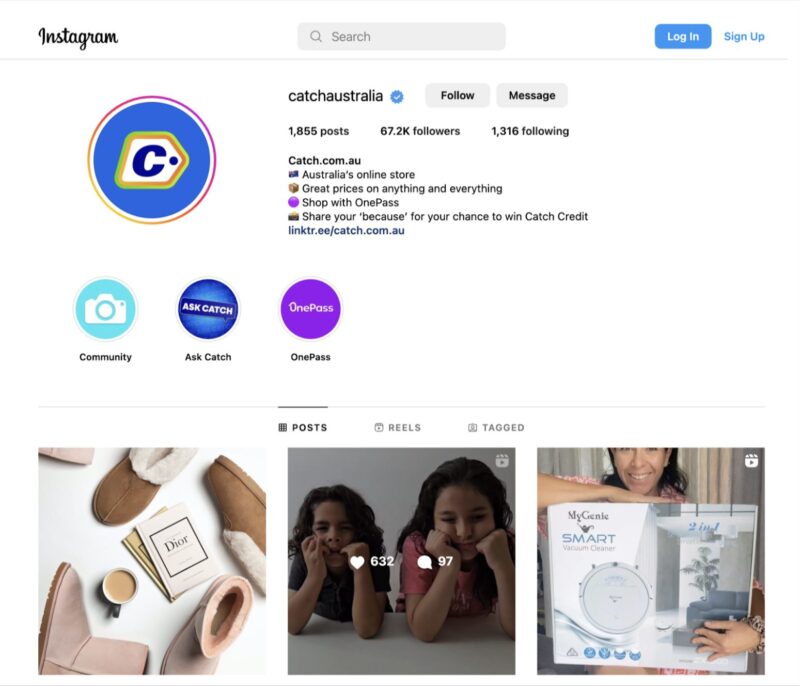
Image credit: Instagram
When you click on Catch’s “Instagram Reels,” you’ll notice that these short video clips receive significantly more engagement than images. This suggests that Reels are outperforming static content on the platform.
As social media evolves, businesses and creators must adapt their strategies to capitalise on emerging trends and stay relevant to their audiences. By incorporating Reels into their content mix, they can tap into the growing popularity of short-form videos and increase their reach and engagement on Instagram.
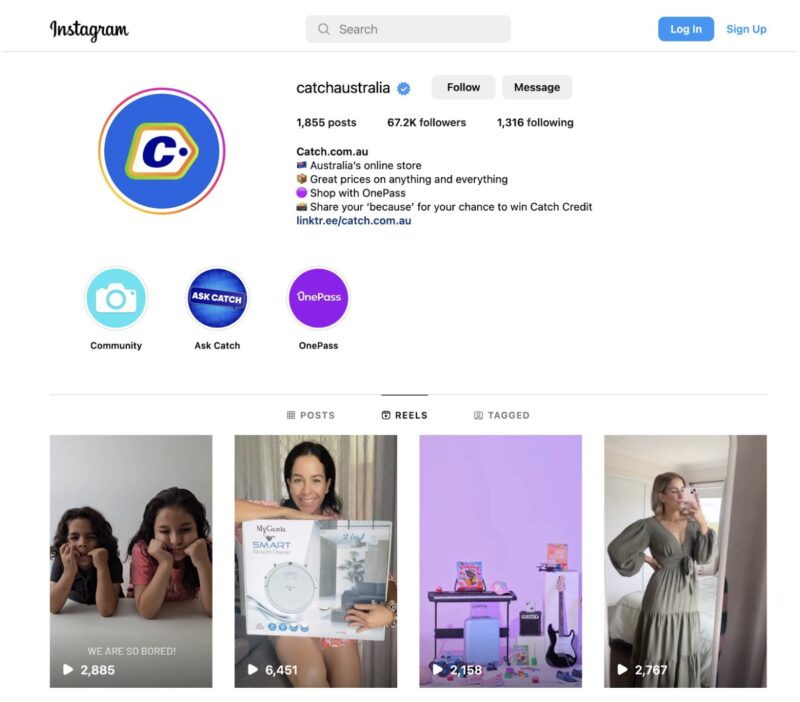
Image credit: Instagram
As you scroll through Catch’s Instagram feed, you’ll likely notice that some of their Reels have garnered over 60,000 views. This highlights short-form video content’s potential reach and impact on social media platforms like Instagram.
TikTok
TikTok videos are typically 15 to 60 seconds long, with the platform’s short-form format encouraging users to create bite-sized content that’s visually engaging, easy to consume, and shareable. The short videos users create and share are called “TikToks.”
Catch has 16,400 followers. By scrolling through their feed, you’ll immediately notice that their engagement levels are significantly higher than their presence on other social media platforms.
Catch’s TikTok account has proven highly successful, with some videos amassing over 3.7 million views.
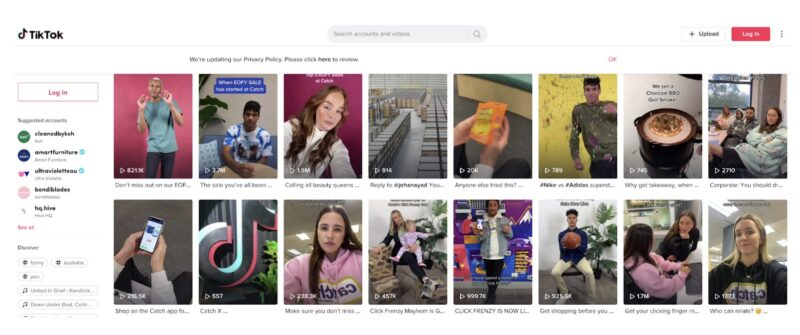
Image credit: TikTok
For example, Catch’s TikTok video featuring a young girl in a Catch t-shirt saying, “You crazy, you crazy girl,” and a relatable caption about leaving sales items in a cart is likely aimed at appealing to their target audience of bargain-hunting shoppers who enjoy finding great deals on the Catch website.
The video’s playful and relatable nature, combined with its use of a young girl, may also help to increase brand awareness and engagement among younger TikTok users.
Catch has garnered an impressive 703,559 likes on Facebook. A closer look at their page feed reveals that many posts receive between 4 and 12 likes. Some content also attracts negative comments about customer service, shipping and fulfilment, or faulty products.

Image credit: Facebook
Catch has a proactive approach to customer service on Facebook. The company responds promptly to customer inquiries and complaints and engages with customers to address their concerns and provide helpful solutions.
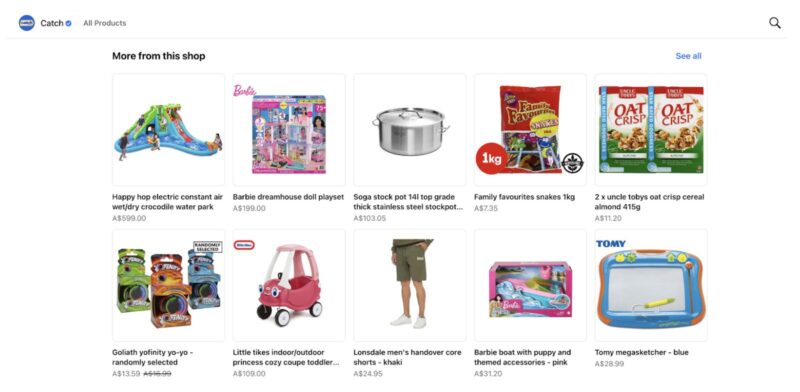
Image credit: Facebook
By setting up a Facebook Shop storefront, Catch can leverage the benefits of this powerful Ecommerce platform to showcase and sell its products directly to customers on Facebook while also taking advantage of the social media giant’s extensive reach and advertising capabilities to attract and engage potential customers.
Using these metrics alone may not always be enough to get a clear picture of what is happening, as we do not have access to Catch’s data through Facebook Business Manager. To investigate further, you could use a tool like Similarweb to see if any other trends or patterns need to be more apparent.
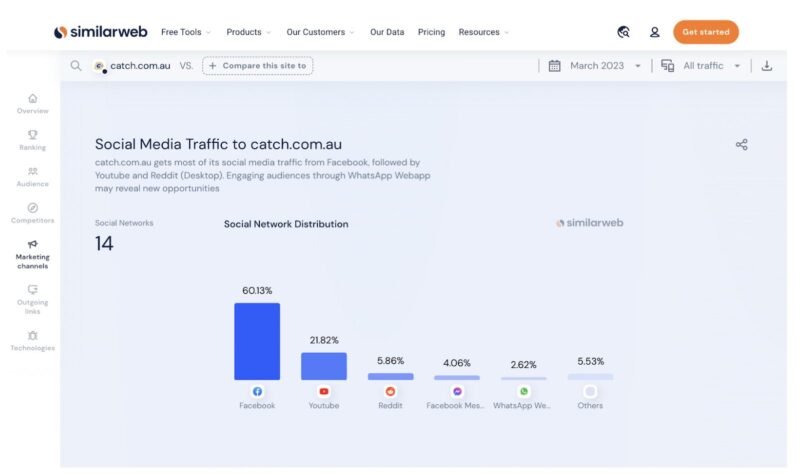
Image credit: Similarweb
While from an engagement standpoint, Catch appears to be gaining more traction on TikTok — Facebook is the winner, which accounts for approximately 60% of its web traffic. There could be several reasons behind this, such as Facebook ads or organic activities from customers in Facebook groups and people sharing and discussing items on their Facebook Feed.
Catch is an active user of Pinterest, with 10,700 followers on their account. While some of their images may receive little user engagement, the company’s Pinterest profile still generates significant free exposure, with approximately 638,500 monthly views.
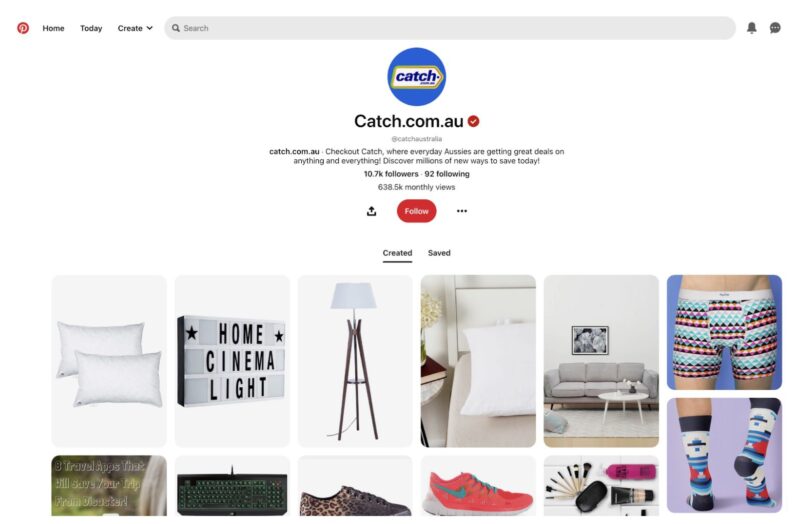
Image credit: Pinterest
By maintaining an active presence on the platform, Catch can leverage the visual appeal of its products and expand its reach to a broader audience of potential customers.
SEO audit
Conducting a competitor SEO audit can be an essential strategy for brands looking to gain a competitive edge in search engine rankings. It can be done using various SEO tools such as Ahrefs, Semrush, Moz, Spyfu, and Screaming Frog.
To gain valuable insights into a website’s SEO performance, Ahrefs is a widely used SEO tool among many digital marketing agencies. Through Ahrefs, we can analyse a website’s backlinks, search rankings, and other key SEO metrics.
By using Ahrefs to conduct a competitor SEO audit of Catch, we can gain valuable insights into their SEO strategies and performance. Let’s dive into the data to uncover critical metrics such as their backlink profile, top-performing pages, and keyword rankings.

Opening up Ahrefs’ Site Explorer and clicking on Overview shows the following metrics:
- Domain rating (DR): A metric that indicates the strength of a website’s backlink profile based on factors like the quality and quantity of backlinks, link diversity, and relevance.
- Backlinks: The total number of links pointing to a specific website.
- Referring domains (RDs): The total number of unique websites linking to a website.
- Organic keywords: Organic keywords are the search terms or phrases a website ranks for in search engine results pages (SERPs) without paid advertising.
- Organic traffic (OT): Organic traffic refers to website visits from unpaid search engine results instead of paid ads.
- Traffic value: An estimation of the organic search traffic value a website receives from its top-ranking keywords and assigning a cost-per-click (CPC) value to that traffic based on the keyword’s commercial intent.
By clicking on the “traffic value” function, Catch’s competitors can identify the most critical keywords for their digital marketing efforts. A competitor can optimise their campaigns by focusing on these keywords to drive the highest traffic to their website.
This data-driven approach allows them to allocate resources more effectively and improve their digital marketing strategy.

It’s worth noting that Catch’s brand is powerful, evidenced by the impressive 286,000 organic brand name searches they receive each month.
Interestingly, their top-performing page belongs to the adult entertainment industry. This may explain why Catch updates its homepage in the evenings to feature an “after dark” section, as this is likely a high-performing sales category.
After spending a few minutes looking through Catch’s most recently acquired backlinks, I found a few things:
- News article stories about Catch.
- Image links linking to specific products.
- Insights into their link acquisition strategy.
I noticed that Catch has strategically built links to their Catch Connect page. This indicates a deliberate decision by either their head of growth or head of SEO to boost sales for their prepaid mobile plans.

Image credit: Catch
To validate this assumption, I can plug this URL into Ahrefs’ Site Explorer Overview 2.0, then click on “Exact URL” to investigate more, such as the number of backlinks, referring domains, organic search traffic, and top keywords associated with the page. Let’s take a look.

From this data, we can see a few things:
1. Catch has obtained 115 unique referring domains (backlinks) to their Catch Connect page, indicating that they are currently running a link building.
2. The page’s ranking has dramatically increased from May until now due to its link building campaign.
3. The page also ranks for over 1,600 keywords, bringing around 931 monthly clicks.
4. Catch has also allocated a small percentage of its ad budget to advertising this page on Google.
PR audit
Various tools are available to track competitors’ media coverage and evaluate their PR efforts. While some options like Meltwater and Cision can be pricey, more affordable alternatives like Mention and Brand24 offer simultaneous monitoring of PR, social media, and forum mentions.
![]()
Image credit: Software Advice
Many SEO tools can be used to uncover stories about a brand, providing valuable insights into how a company is perceived and discussed online. By leveraging these tools, businesses can stay on top of their competitors’ media presence and identify opportunities to improve their public relations strategies.
Brands also use manual searches, for example, Google Search Operators (commands that refine Google searches). For example, I could type “catch.com.au” into Google. Then click on:
- Tools: To adjust the date (for example, past month).
- News: To view any news stories about Catch.
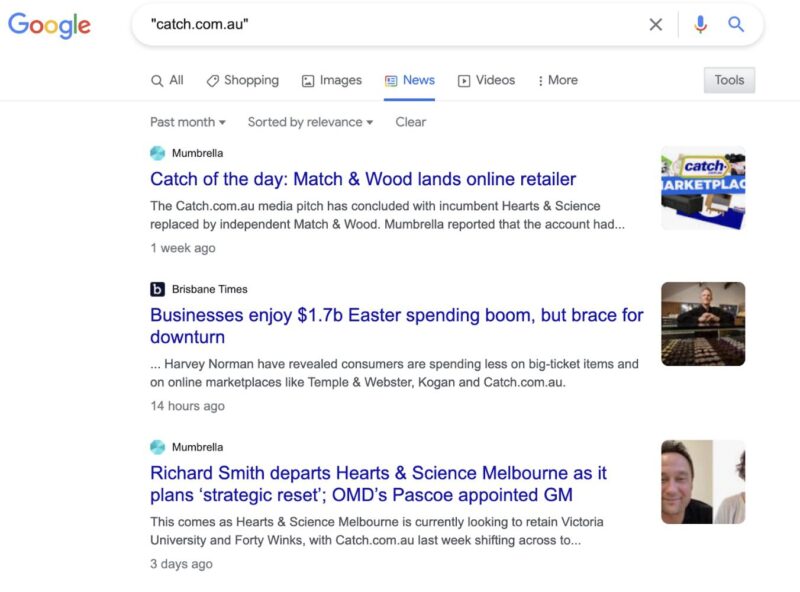
Image credit: Google
Usually, I wouldn’t use the Search Operator “catch.com.au” instead of “Catch” if it’s a brand name that doesn’t contain other meanings. But in this case, “catch” could mean anything, so I used the branded URL search query instead of a branded name search.
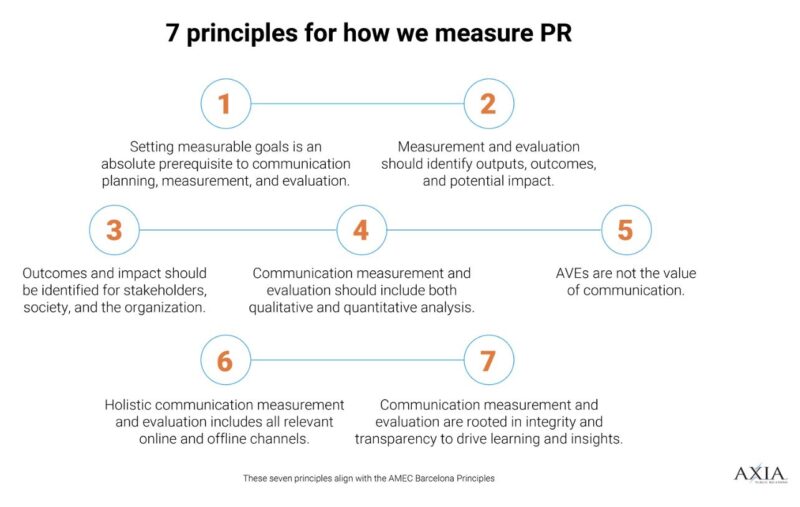
Image credit: AXIA Public Relations
I could analyse and categorise these PR stories. For example, evaluating the tone and framing of the stories, identifying key themes and messages, and comparing coverage against competitors can provide a complete understanding of the brand’s media presence.
Identifying key themes and messages from the PR stories can help you develop a content strategy that resonates with your target audience and aligns with the brand’s messaging and values.
Comparing coverage against competitors can provide a benchmark and guide strategic decision-making, such as where to allocate resources and what channels to prioritise.
Marketing tech stack audits
Several tools can help you identify the marketing technology tools your competitors are using, such as BuiltWith or StackShare.
These tools provide valuable insights into your competitors’ marketing strategies, allowing you to stay ahead of the competition and will aid your brand in creating a digital marketing strategy.
Let’s take Catch as an example and use BuiltWith to uncover valuable insights about its marketing technology stack.
- Google Publisher Tag: Enables Catch to serve ads through Google Ad Manager and optimise ad delivery.
- Doubleclick.net: This advertising platform provides real-time bidding, ad exchange, and data management features.
- Criteo: This retargeting tool helps Catch show ads to users who have previously interacted with their website or products.
- Google Remarketing: A feature that enables Catch to show ads to users who have previously visited their website or engaged with their brand.
- Google Floodlight Sales: A tool that tracks conversions and other key metrics related to Catch’s advertising campaigns, allowing them to optimise their campaigns for better performance.
- Facebook Reseller: Allows Catch to purchase ads through Facebook’s advertising platform and target specific audiences based on their interests and behaviour.
- App-ads.txt: This helps Catch prevent unauthorised sellers from selling their ad inventory.
![]()
Image credit: BuiltWith
BuiltWith also shares a lot of other useful information, such as:
- Analytics and tracking.
- Widgets.
- Content delivery network.
- Payment providers.
- Content management systems.
- Shipping providers.
- Email hosting providers.
Analysing competitors’ marketing tech stack can help a business identify industry trends, benchmark their marketing efforts, and uncover opportunities for improvement, ultimately informing the development of a more effective and competitive digital marketing strategy.
Step 2: Set goals for your digital marketing strategy
Setting clear and measurable goals is essential to creating an effective digital marketing strategy. By understanding your audience and competitors, you can establish goals that align with your business’s mission and provide a measuring point for your advertising performance and progress.
When setting goals, it’s important to take a realistic and achievable approach and define clear deadlines to ensure the timely delivery of campaigns. That’s where the SMART framework comes in.
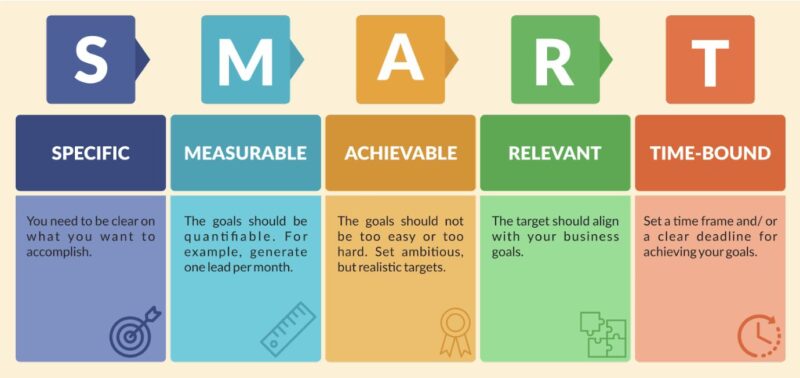
Image credit: LaunchSpace
The SMART framework stands for Specific, Measurable, Achievable, Relevant, and Time-bound and can be applied to creating a digital marketing strategy.
- Specific: Goals should be well-defined and precise.
- Measurable: Goals should be quantifiable so that progress can be tracked.
- Achievable: Goals should be realistic and attainable within resources and constraints.
- Relevant: Goals should align with the business strategy and objectives.
- Time-bound: Goals should have a specific timeline for completion and be tied to a deadline.
Dr Dave Chaffey, the author of Digital Marketing: Strategy, Implementation and Practice created the RACE Framework, a digital marketing structure that enables marketers to plan, manage, and optimise all aspects of their customers’ online and offline brand experiences.
The RACE Framework provides a structured approach to digital marketing planning, implementation, and optimisation, which can help businesses to achieve their digital marketing goals and objectives.
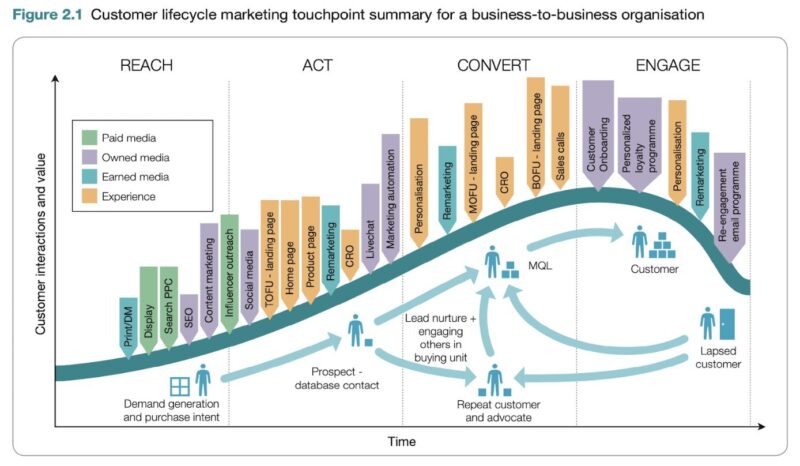
Image credit: Smart Insights
By following the RACE Framework, businesses can focus on the proper channels and tactics and use the most appropriate metrics and KPIs to measure their success.
Another alternative to using the RACE Framework would be the ICE scoring method, created by Sean Ellis, the founder of Growth Hackers.
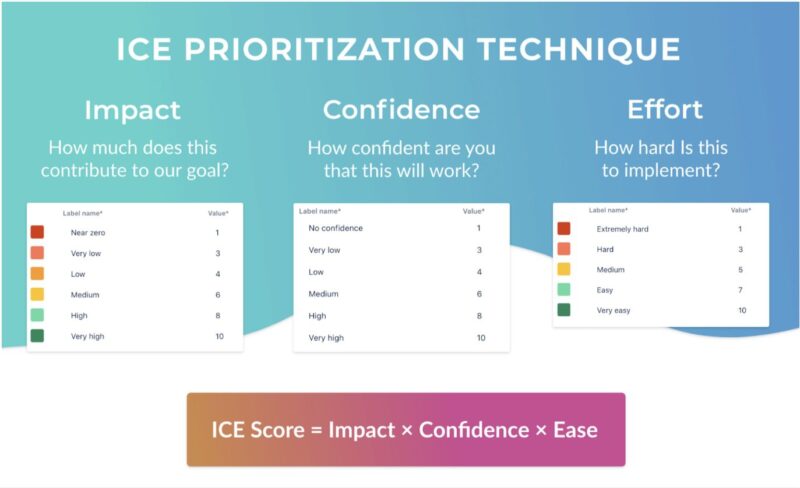
Image credit: Zeda
This is a popular strategy used in agile marketing teams to prioritise growth marketing experiments and initiatives based on their potential impact, confidence, and ease of implementation.
The system assigns a score to each experiment on a scale of 1-10, with higher scores indicating a larger impact.
- The “I” in ICE stands for impact, which refers to the potential impact that an experiment or initiative may have on the business. This could include increased revenue, improved customer retention, or enhanced brand awareness.
- The “C” in ICE stands for confidence, which refers to the level of confidence the marketer has in the experiment or initiative. This could include past data, market research, or expert opinions.
- The “E” in ICE stands for ease of implementation, which refers to the ease with which the experiment or initiative can be implemented. This could include available resources, technical requirements, or time constraints.
Another popular alternative to the ICE scoring method is the RICE Scoring Model. Intercom developed this to improve its internal decision-making processes.
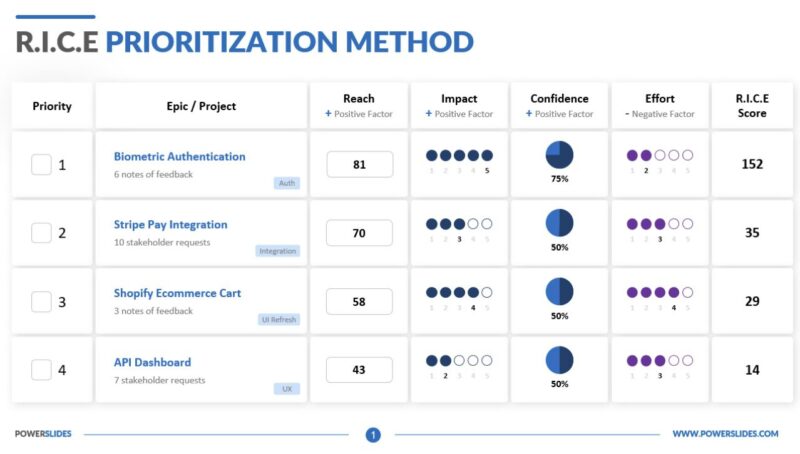
Image credit: PowerSlides
One of the advantages of the RICE model is that it considers the reach or the potential number of customers that a given experiment might impact. However, one of the drawbacks of the RICE model is that it may only sometimes account for the level of confidence or certainty that a marketer has in a given experiment.
In terms of popularity, both the ICE and RICE models are widely used by marketers, with each model having its strengths and weaknesses.
Step 3: Create an engaging website that’s mobile-friendly
As more and more people access the internet through mobile devices, it’s essential to ensure your website is mobile-friendly. To create an engaging website that caters to all users, follow these steps:
- Focus on creating an engaging website that appeals to your target audience.
- Optimise your website for all devices, including desktops, tablets, and mobiles, to ensure users can perform any action efficiently.
- Use tools like Google’s Mobile-Friendly Test to evaluate your website’s mobile-friendliness and receive insights to keep it error-free. This test offers suggestions to optimise your website for mobile usage.
- Keep in mind that mobile-friendly websites are preferred by top search engines like Google and Bing, making it more likely that your website will rank higher in search results.
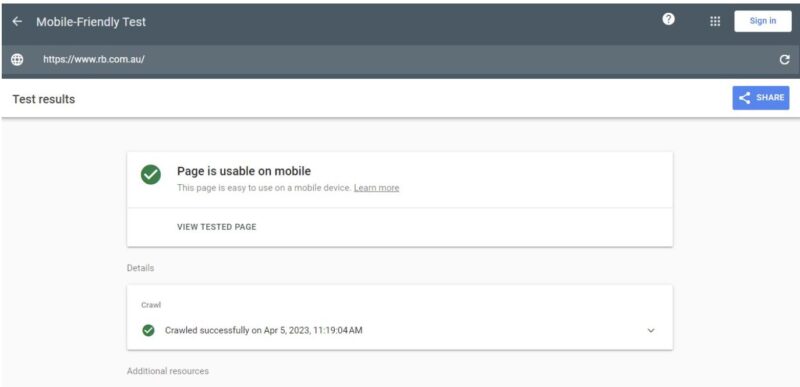
Image credit: Google
Here are some tips for creating a mobile-friendly website that can engage more leads and customers:
- Opt for a responsive and fast layout that adapts to all screen sizes.
- Choose a fast hosting provider to optimise website speed.
- Keep the design simple, easy to navigate, and visually appealing.
- Use large buttons that are easy to click on for effortless navigation.
- Avoid using pop-ups and banner ads that can be disruptive to users.
- Compress images to optimise their loading time and improve website speed.
- Use persuasive Call-to-Action (CTA) buttons that encourage users to take action.
- Write content in readable and accessible fonts, ensuring enough white space.
- Test your website on various devices, platforms, and operating systems to ensure it works seamlessly for all users.
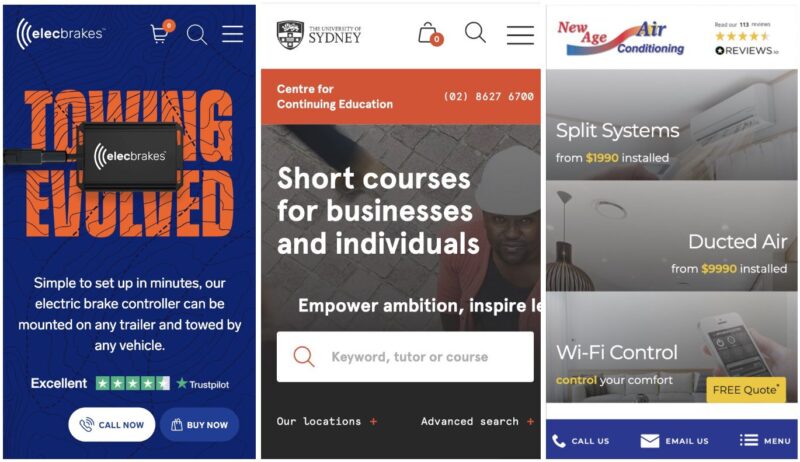
Step 4: Maintain brand uniformity
Promoting your brand across various platforms such as social media, websites, and email is critical in digital marketing. However, it’s equally essential to maintain brand uniformity across all these channels to ensure your customers can quickly recognise your company and products.
Having inconsistent branding across different platforms can confuse visitors and potential customers, leading to a loss of trust and credibility. Therefore, creating a consistent branding strategy is crucial for building a solid brand identity. Here are some steps to help you create a uniform branding strategy.
1. Understand your audience’s needs
Before you start creating your branding strategy, it’s essential to understand your audience’s preferences and expectations. This can be done by creating a buyer persona, which provides valuable insights into your customers’ language, behaviour, and brand preferences that resonate with your target audience.
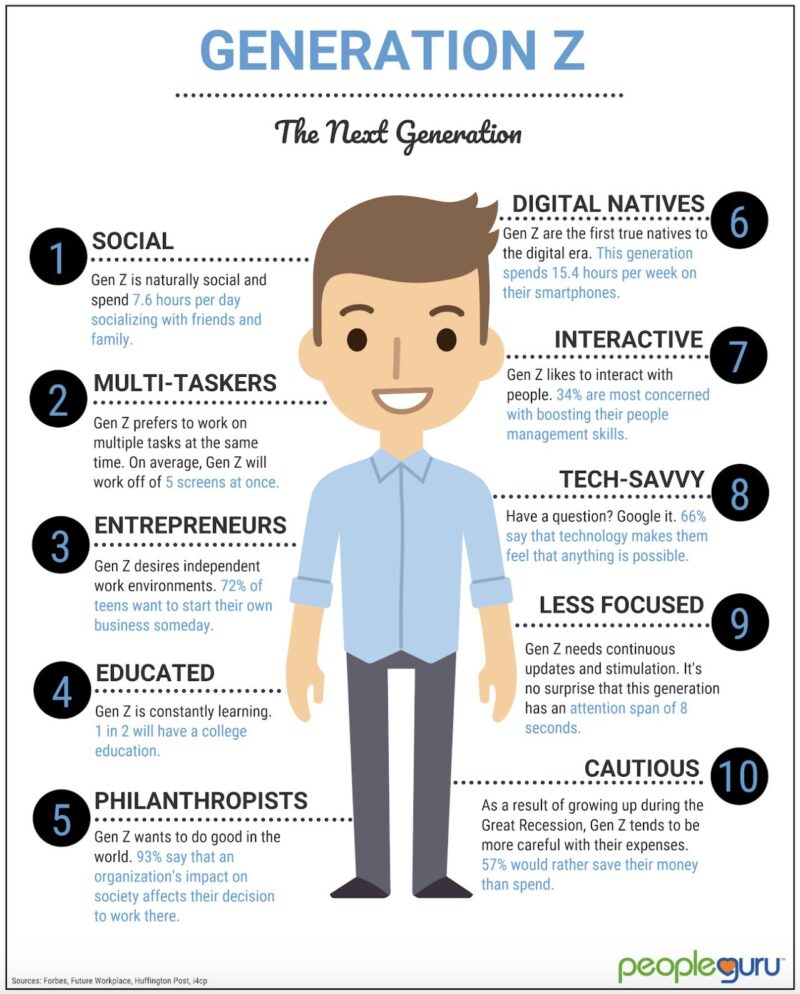
Image credit: People Guru via Pinterest
It’s important to note that different age groups may have unique preferences regarding digital marketing. For example:
- Gen X (born between 1965-1980) prefers email marketing.
- Gen Y or Millennials (born between 1981-1996) often prefer social media and mobile apps.
- Gen Z (born between 1997-2012) has grown up in a highly digitised world and tends to have a shorter attention span, making video and visually engaging content crucial for their engagement.
When creating buyer personas, it’s important to consider demographic factors such as age, gender, location, education, income, and occupation. However, you should also look beyond these essential demographic characteristics and consider other factors influencing your audience’s behaviour and preferences, such as their interests, hobbies, beliefs, values, and cultural background.

Image credit: AWeber
For instance, if you’re creating a digital marketing strategy targeting a specific ethnic group or religious community, you might need to tailor your messaging and branding to align with their cultural norms and values.
Similarly, if your audience consists of people with particular interests or lifestyles, you might need to craft your messaging to appeal to their unique needs and desires.
By taking the time to understand your audience’s diverse backgrounds and characteristics, you can create a more effective digital marketing strategy that resonates with them.
2. Create brand guidelines
Once you have a clear idea of what kind of branding you want, the next step is to create a set of guidelines that will be followed throughout the organisation. These guidelines should include the colours, logo usage, voice and tone of campaigns, fonts and typography, brand mission, media formatting, and graphic styles.
Keeping your target audience in mind, these guidelines will ensure consistency across all your branding efforts. A great example is Canva, which has a dedicated area of its website specifically for brand guidelines.

Image credit: Canva
Canva’s brand guidelines cover everything from logo and colours to typography, illustrations, and even their brand philosophies. Covering every aspect of their visual identity and brand philosophies ensures that every touchpoint with their audience is memorable and meaningful.
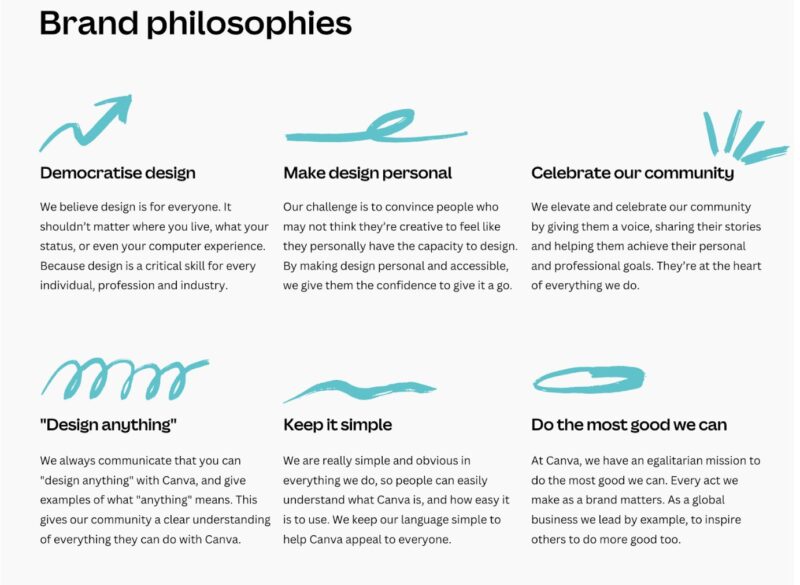
Image credit: Canva
Canva’s brand philosophy is remarkable for democratising design, celebrating community, promoting creativity and simplicity, and doing good. Their commitment to these principles sets a high standard and inspires others to follow suit.
3. Distribute guidelines across all teams
It’s essential to share your branding guidelines across all your teams, including sales, production, marketing, and design. This ensures that everyone creating future campaigns follows the same guidelines, resulting in consistent branding across all channels.
4. Audit and update your existing guidelines
Branding is one of the top ways to represent your organisation and build a strong customer relationship. Therefore, keeping all team members well-versed with any changes or updates to the branding guidelines is essential.
Continuously evolving your branding and keeping up with the latest trends will help you stay connected with your customers and build a strong brand identity over time.
Step 5: Diversify your marketing channels
To succeed in digital marketing, diversifying your approach is vital. You can hedge the risks of a failed plan using various channels and tactics. Diversification also avoids reliance on one particular channel, increasing opportunities to engage with customers.
One framework that can help companies create habit-forming products and services across multiple channels is the Hooked Model, created by Ryan Hoover and Nir Eyal. In this model, businesses can leverage multiple triggers and rewards to reach a wider audience and increase the chances of creating a habit-forming product or service.
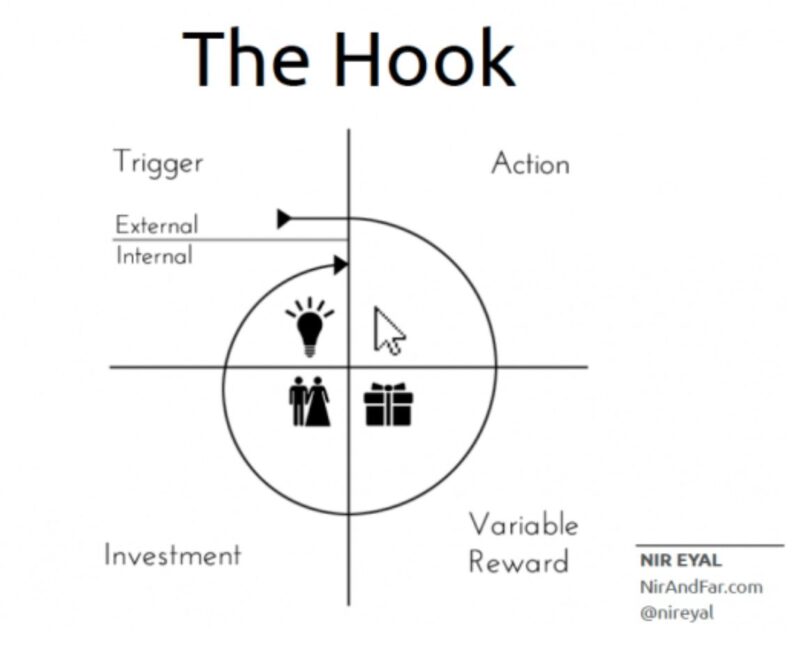
Image credit: Neuro Science Marketing
In addition to the Hooked Model, businesses can use frameworks such as the Bullseye Framework by Gabriel Weinberg, founder of DuckDuckGo, to identify the most effective channels for customer acquisition.
The Bullseye Framework consists of three concentric circles representing three types of channels: outer circle, middle circle, and inner circle, each with its specific characteristics and advantages.

Image credit: Medium
The middle circle channels, such as email marketing and referral programs, are more focused and specific and can be used for customer activation. The inner circle channels are the most targeted and high-converting and can be used for customer retention, such as personal email outreach and loyalty programs.
One interesting thing, from having read the book, is that Gabriel points out that one traction channel might now work right now for a business, but it may work later on, highlighting the importance for brands to continue to
Inner ring
These channels are the most promising and have the highest potential for success. The five channels in this ring are:
1. Viral Marketing
Utilising social media and word-of-mouth to encourage customers to share your product/service with their network. The “Squatty Potty” campaign included a humorous video ad featuring a unicorn that went viral on social media and generated millions of views, leading to a significant increase in sales for the company.
Image credit: YouTube
The campaign was successful because it used humour and irreverence to promote a product that people might not have considered before. It leveraged the power of viral content to generate buzz and interest in the product.
2. Public relations
Using press coverage to generate brand awareness and credibility. Tesla’s Cybertruck unveiling event generates massive media coverage and buzz.
Image credit: YouTube
3. Unconventional PR
Creative stunts or campaigns to get attention and media coverage. The “Elf Yourself” holiday campaign by OfficeMax allowed customers to create personalised dancing elves with their faces.

Image credit: Business Wire
4. Search Engine Marketing (SEM)
Pay-per-click (PPC) advertising and Search Engine Optimisation (SEO) to drive traffic to your website. Coca-Cola uses Google Ads to target people searching for “holiday drinks” and other festive terms during the holiday season.
Since then, Coca-Cola has stepped it up and introduced a marker-based AR app that lets customers scan a polar bear to see if it comes to life.
Image credit: Medium
5. Social and display ads
Advertising on social media platforms and other display networks to reach your target audience. Airbnb’s “Live There” campaign uses Instagram and Facebook ads to target travellers with custom visuals and messaging.
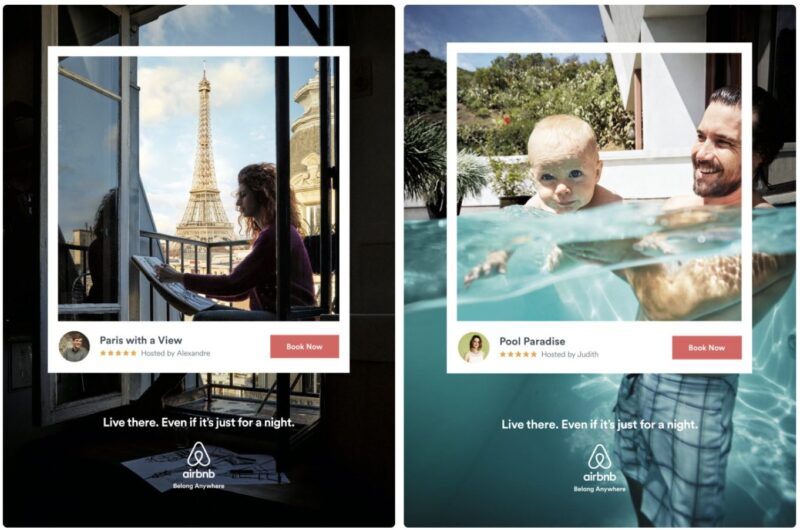
Image credit: Dexigner
Middle ring
These channels are promising and have some potential for success. The six channels in this ring are:
6. Offline ads
This traction channel includes promoting your business through traditional media channels, such as billboards, newspapers, magazines, radio, or TV, to reach potential customers who need to start using the Internet.
Coca-Cola ran a billboard campaign in Vietnam that dispensed free cans of Coke when customers pressed a button on the billboard. The billboard featured a large red button and a slot where customers could insert a bottle or can to recycle.

Image credit: Behance
When a customer recycled a bottle or can and pressed the button, a can of Coke would be dispensed from the billboard. The campaign was an effective way to encourage recycling and generated positive buzz for the Coca-Cola brand.
7. Content marketing
Creating valuable content, such as blog posts, ebooks, and videos, to attract and engage potential customers. HubSpot’s “Academy” offers free online courses and resources to educate and attract potential customers.
8. Email marketing
Building a list of email subscribers and sending targeted messages to promote your product or service. Buzzfeed’s daily newsletter features trending news and viral content to drive traffic to its website.
9. Engineering as marketing
Building tools or products that attract potential customers and showcase your expertise. Sometimes, this is also called “side marketing.” Tesla’s online calculator allows users to estimate energy savings from solar panels and other sustainable energy solutions.
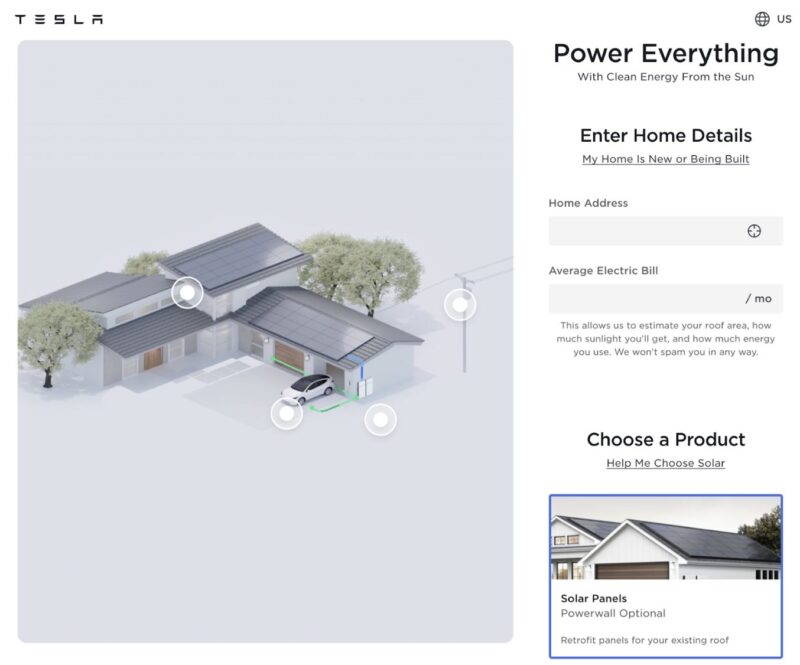
Image credit: Tesla
10. Targeting blogs
Writing guest posts on relevant blogs to reach your target audience. A software company called Trello targeted popular project management blogs by creating guest posts, tutorials, and infographics that helped project managers solve everyday problems.
11. Business development
Partnering with other businesses or organisations to expand your reach and acquire new customers. The meal kit company Blue Apron partnered with celebrity chef Chrissy Teigen to create a series of meal kits, which helped to expand their customer base and increase sales.

Image credit: Retail Touch Points
Outer ring
These channels have a lower potential for success but are still worth considering. The eight channels in this ring are:
12. Sales
Utilising sales tactics like cold calling and direct mail to generate leads and close deals. The CRM software company Salesforce grew its customer base through targeted email campaigns and cold-calling prospects.
13. Affiliate programs
Offering incentives to other businesses or individuals to promote your products or services. Amazon’s affiliate program, Amazon Associates, has enabled millions of bloggers and content creators to monetise their content by promoting Amazon products to their audiences.
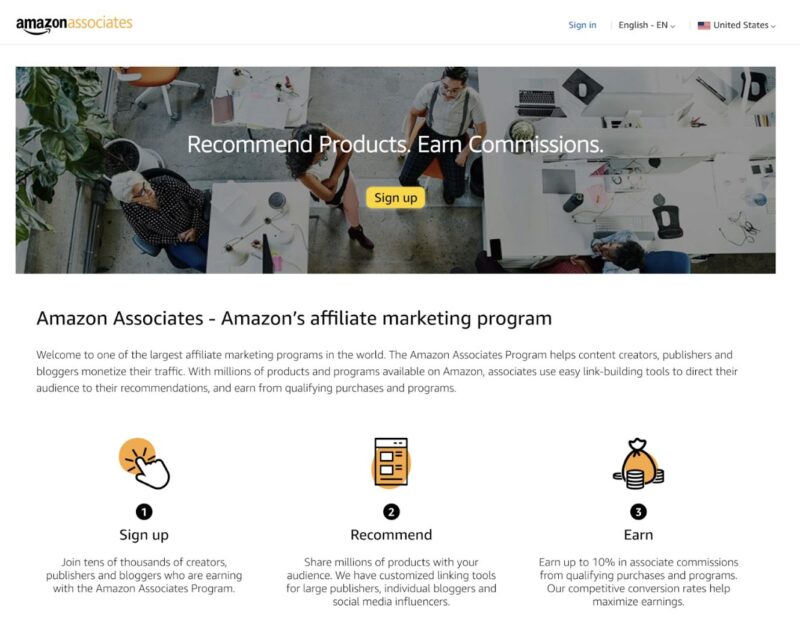
14. Existing platforms
Utilising existing platforms, such as marketplaces or social media networks, to reach new customers. Nike uses Snapchat’s augmented reality filters to let customers try on and purchase shoes within the app.
15. Trade shows
Exhibiting at industry trade shows to generate leads and showcase your product or service. The outdoor gear company Patagonia regularly exhibits at outdoor trade shows, which helps to connect them with retailers and customers and establish their brand as a leader in the outdoor space.

Image credit: Outside
16. Offline events
Hosting or attending events, such as workshops or conferences, to connect with potential customers. The music streaming platform Spotify created a series of interactive installations in New York City to promote their service, which included a giant ball pit filled with foam musical notes.
17. Speaking engagements
Speaking at conferences or events to establish yourself as an industry expert and generate brand awareness. Simon Sinek’s TED Talk “How Great Leaders Inspire Action” helped to establish him as a thought leader and drive book sales.
Image credit: TED Talks
18. Community building
Building and engaging with a community of customers or fans around your brand. The health and wellness company Peloton has built a dedicated community of customers through its social media channels, creating engagement through user-generated content and connecting customers.

Image credit: CNBC
19. Sponsorships
This traction channel involves supporting an event, sports team, or organisation to promote your brand and increase your exposure to a specific target audience. For years, Red Bull has sponsored extreme sports events like Red Bull Air Race and Rampage.

Image credit: Red Bull
By associating themselves with these exciting and daring events, Red Bull has built a strong brand identity as an energy drink for extreme and adventurous individuals.
Step 6: Determine the budget and resources for your digital marketing strategy
A critical element to consider when creating your strategy is determining your budget and resources. It’s essential to effectively allocate the right resources and budget to achieve your goals.
One important consideration is whether you will handle all your digital marketing efforts in-house or outsource to a digital marketing agency. While in-house marketing provides greater control and flexibility, it can be more expensive and time-consuming.
On the other hand, outsourcing can be cost-effective and bring more specialised expertise, but it requires finding the right agency that aligns with your business goals and values. Ultimately, the decision will depend on your unique situation, goals, and available resources.
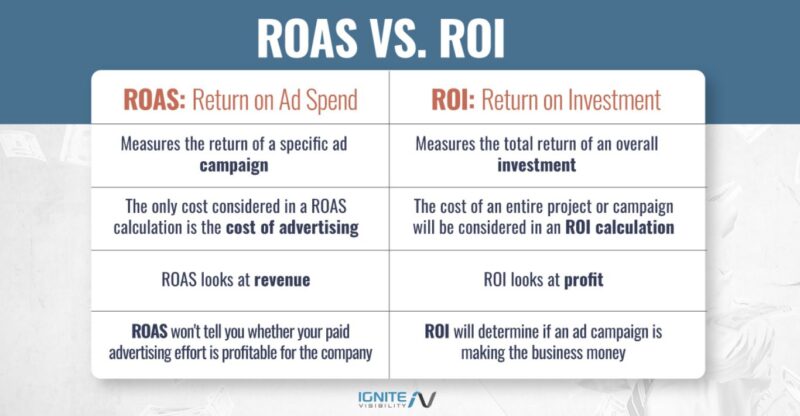
Image credit: Ignite Visibility
Once you have determined your marketing goals and allocated your resources, consider different metrics impacting your budget, such as return on investment (ROI) and return on ad spend (ROAS). By regularly monitoring and analysing these metrics, you can adjust your marketing strategy and budget accordingly to maximise your return on investment.
Step 7: Measure your campaign success
Here is how to effectively measure the success of your digital marketing campaign and make data-driven decisions to optimise future campaigns.
1. Determine your campaign objectives
The first step in measuring the success of your digital marketing campaign is to determine your campaign objectives.
- What do you want to achieve with your campaign?
- Are you looking to increase website traffic, generate leads, improve brand awareness, or increase sales?
Defining your campaign objectives will help you determine metrics to track and measure.
2. Choose relevant KPIs
Once you have defined your campaign objectives, you must choose relevant key performance indicators (KPIs) to measure.
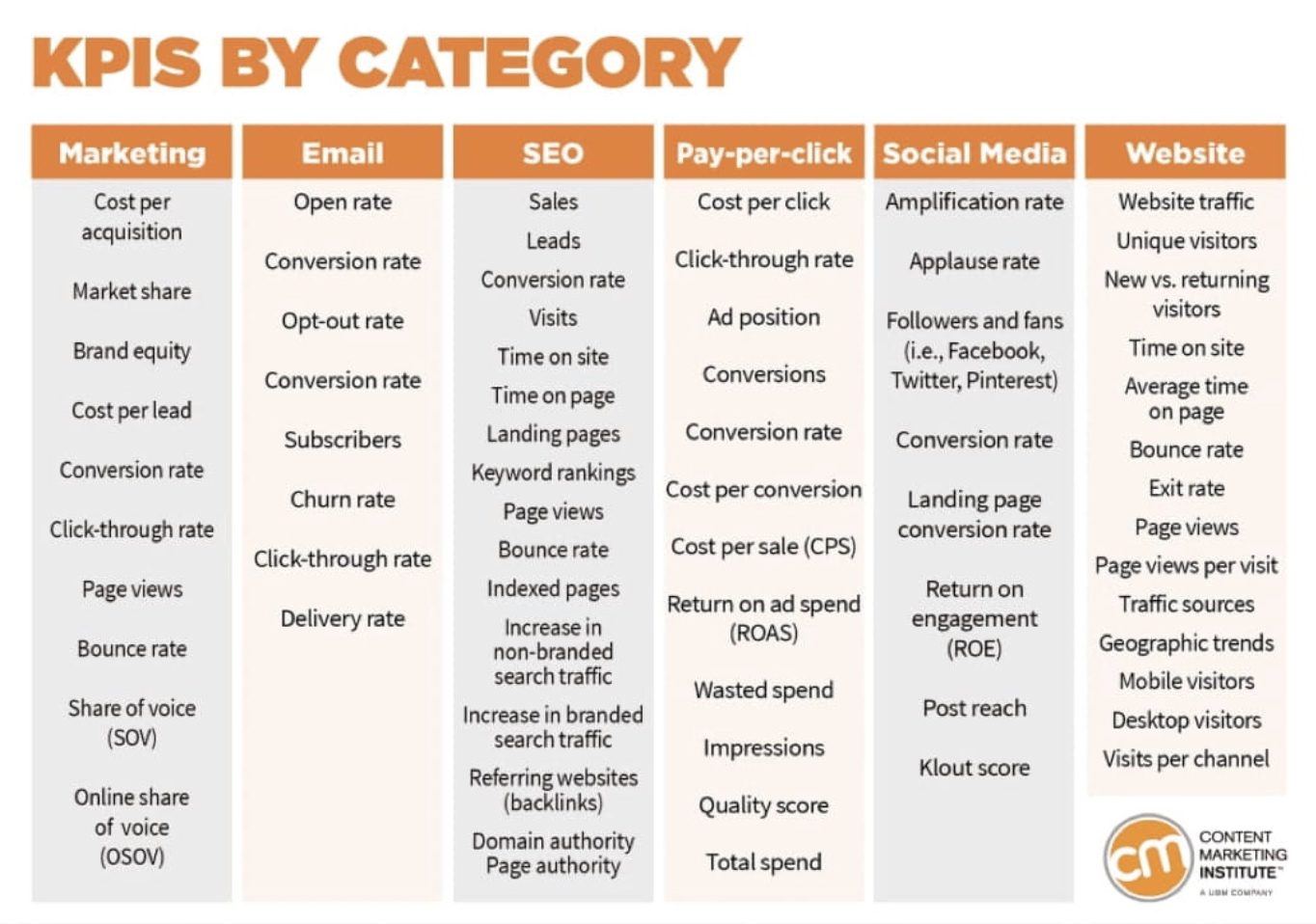
Image credit: Content Marketing Institute
For example, if your objective is to increase website traffic, you might track metrics such as website sessions, bounce rate, and time on site. You might track metrics such as conversion rate, lead quality, and cost per lead to generating leads.
3. Set benchmarks
Before launching your digital marketing campaign, set benchmarks for your chosen KPIs. These benchmarks should be based on historical data or industry standards.
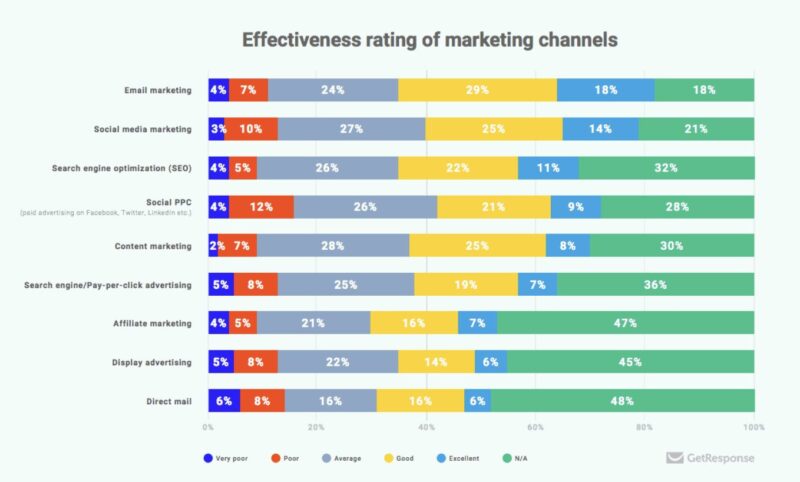
Image credit: Smart Insights via GetResponse
Setting benchmarks will help you evaluate the success of your campaign against a pre-determined baseline.
4. Track and measure performance
Once your campaign is up and running, track and measure the performance of your chosen KPIs.
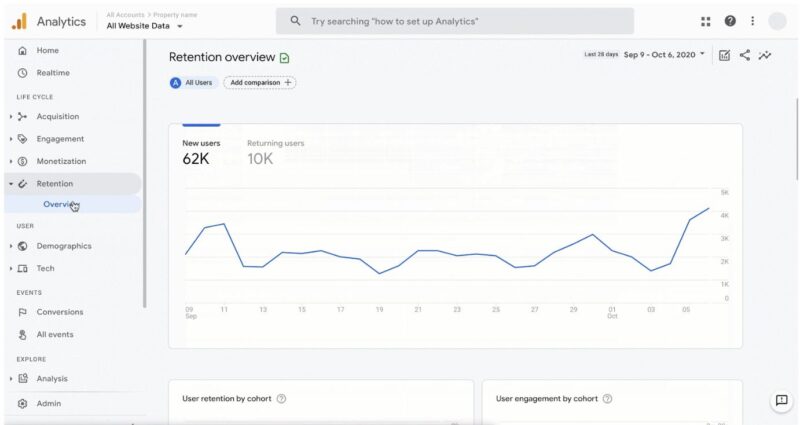
Image credit: Google
This can be done using various tools, such as Google Analytics, social media analytics, and email marketing software. Monitor your KPIs regularly and look for trends and patterns over time.
5. Analyse and optimise
After your campaign has run for some time, analyse your data to identify areas of success and improvement. Use this data to optimise your campaign by adjusting your messaging, targeting, and tactics. Continuously test and refine your campaign to improve performance over time.
6. Evaluate ROI
Evaluate your digital marketing campaign’s return on investment (ROI). This can be done by comparing the cost of your campaign to the revenue generated or leads generated.

Image credit: First Page Sage
Use this information to determine if your campaign was successful and worth the investment.
Digital marketing strategy checklist
1. Define your brand: Identify your unique selling proposition (USP), brand voice, and brand personality. This will help you differentiate yourself from competitors and establish a consistent brand image across all digital channels.
2. Define your target audience: Determine your ideal customer by creating a buyer persona. This will help you tailor your digital marketing efforts to the needs and preferences of your audience.
3. Set SMART goals: Define specific, measurable, achievable, relevant, and time-bound goals for your digital marketing efforts. This will help you stay focused and track your progress.
4. Conduct a SWOT analysis: Assess your strengths, weaknesses, opportunities, and threats related to your digital marketing efforts. This will help you identify areas for improvement and potential growth opportunities.
5. Determine your budget: Set a realistic budget for your digital marketing efforts based on your goals and available resources.
6. Choose your digital channels: Select the digital channels that are most effective for reaching your target audience and align with your brand voice, such as social media, email marketing, content marketing, PPC advertising, and SEO.
7. Develop your content strategy: Plan your content creation and distribution strategy, including the topics, formats, and channels that best engage your audience and align with your brand voice.
8. Optimise your website: Ensure your website is optimised for search engines and user experience, including mobile optimisation, fast load times, and easy navigation.
9. Implement analytics: Set up analytics tracking to monitor your digital marketing performance, including website traffic, engagement, conversions, and ROI.
10. Test and optimise: Test and optimise your digital marketing efforts based on data insights, feedback, and industry trends.
11. Evaluate and adjust: Regularly evaluate your digital marketing strategy and adjust it based on performance and market changes.
12. Define your brand crisis management strategy: Determine how to handle negative feedback, manage online reputation, and maintain brand integrity during a crisis.
Digital marketing trends for 2025
The digital marketing game is evolving fast, and 2025 is bringing in some serious shifts. From AI-powered strategies to hyper-personalised content, brands that stay ahead of these trends will dominate. Let’s dive into the biggest marketing moves shaping the year ahead.
AI, AI, AI
AI is no longer just a tool—it’s changing the way marketing works. Businesses using AI-driven analytics can now predict customer behaviour, automate ad bidding, and create hyper-relevant AI content at scale. AI chatbots are also getting smarter, offering real-time support that feels almost human.
The key takeaway?
In 2025, AI isn’t optional, it’s essential. Businesses that embrace its automation and insights will save time, improve accuracy, and create more impactful marketing campaigns.
Actionable tip: Use content tools like ChatGPT for brainstorming ideas instantly, and advertising platforms like Google Ads Performance Max for automated targeting and budget optimisation.
Hyper-personalisation
Generic content won’t always cut it anymore. For many communications, customers expect experiences that feel custom-made for them. And AI-driven personalisation makes that possible.
From personalised email sequences based on user actions to dynamically tailored website experiences, businesses that offer ultra-relevant interactions will see higher engagement and sales.
Actionable tip: Implement behavioural segmentation in your email marketing and use dynamic content on your website that adapts based on user preferences.
Augmented Reality (AR)
AR isn’t just a futuristic gimmick—it’s a powerful tool for reducing purchase hesitation.
Whether it’s letting users virtually try on a pair of shoes or see how a couch fits in their living room, AR enhances the buying experience and reduces return rates.
Actionable tip: Integrate AR features into your Ecommerce platform. If you sell physical products, offer a “try before you buy” experience with AR filters or apps.
Voice search
With millions of searches now happening through voice assistants, traditional keyword strategies need an upgrade.
Voice searches are more conversational and often framed as questions—so optimising content to answer these queries is key.
Actionable tip: Focus on long-tail keywords, FAQ-style content, and featured snippets that directly answer common voice search queries.
Short-form video
If your brand isn’t creating short-form videos, you might be missing out on potential customers — particularly younger audiences.
TikTok, Instagram Reels, and YouTube Shorts dominate online engagement, and businesses that deliver engaging, snackable content generally outperform those relying on static posts.
Actionable tip: Focus on storytelling within the first three seconds of your video. Use trending audio, behind-the-scenes footage, and customer testimonials in short-form formats.
Social commerce
Social media isn’t just for engagement anymore—it’s a full-blown sales platform. Instagram, TikTok, and Facebook all have integrated shopping features, allowing customers to browse and buy without leaving the app.
So, if you sell products online, it’s time to streamline the path to purchase within social feeds.
Actionable tip: Use shoppable posts and live shopping events to drive direct sales from social platforms. If relevant for your brand and audience, consider partnering with influencers to showcase products in action.
Strong data security
Privacy concerns are at an all-time high, and businesses that fail to prioritise customer data protection will lose trust fast.
With tighter regulations on third-party tracking, many brands will need to shift towards first-party data strategies and transparent consent policies.
Actionable tip: Collect and leverage first-party data through loyalty programs and interactive content (quizzes, surveys). Be upfront about data collection and give customers control over their privacy settings.
Authenticity
Today’s audiences can spot inauthentic marketing from a mile away. Brands that get ahead in 2025 will focus on real storytelling, customer-generated content, and genuine interactions over highly polished, corporate messaging.
Actionable tip: Encourage user-generated content (UGC), showcase real customer experiences, and engage directly with your audience on social platforms.
Sustainability
In 2025, consumers care about making value-driven purchases. That means businesses need to back up their sustainability claims with real action.
Whether it’s eco-friendly packaging, ethical sourcing, or carbon-neutral operations, brands that prioritise transparency will be set to build stronger customer loyalty.
Actionable tip: Share your sustainability efforts through content marketing. Use certifications and social proof to reinforce your brand’s ethical commitments.
Upgrade your digital marketing strategy with Redback
Creating a digital marketing strategy may present challenges for brands, but it is still possible to develop a successful plan. Staying up-to-date with the latest digital trends and technologies enables brands to seize new opportunities for connecting with their target audience.
Brands can also understand their audience by listening to their needs and preferences and creating engaging content that resonates with them. To track the ROI of their digital marketing efforts, brands can analyse data and metrics, leading to informed decision-making.
With a customer-focused and strategic approach, your business can differentiate itself from competitors and achieve long-term success through digital marketing.
Our marketing specialists are here to help. Chat to us today to discover how we can support you to stand out and grow with creative, measurable and impactful strategies.
